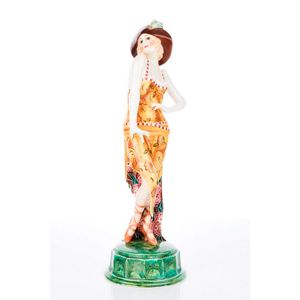Art Deco Lady Figure by Josef Lorenzl for Goldscheider
You must be a subscriber, and be logged in to view price and dealer details.
Subscribe Now to view actual auction price for this item
When you subscribe, you have the option of setting the currency in which to display prices to $Au, $US, $NZ or Stg.
- Art Deco Period - The Art Deco period was a cultural movement that emerged in the 1920s and 1930s, and was characterized by its emphasis on modernism, luxury, and elegance. The name "Art Deco" comes from the Exposition Internationale des Arts Décoratifs et Industriels Modernes, a large exhibition held in Paris in 1925 that showcased the latest trends in decorative arts.
Art Deco was a reaction against the ornate and elaborate styles of the previous era, and reflected a new modern sensibility. It was characterized by streamlined, geometric shapes, bright colours, and the use of new materials such as chrome, glass, and Bakelite. Art Deco designers sought to create a sense of luxury and sophistication, often incorporating expensive materials such as ivory, marble, and rare woods.
Art Deco had a significant impact on a wide range of artistic fields, including architecture, fashion, graphic design, and interior design. Some of the most iconic examples of Art Deco architecture include the Empire State Building in New York City, the Hoover Building in London, and the Palais de Chaillot in Paris.
The Art Deco period came to an end in the 1940s, as World War II and changing cultural trends led to a shift in artistic styles. However, Art Deco remains an important influence on design and art, and continues to be celebrated for its modernist sensibility and glamorous aesthetic. - Earthenware - A basic ceramic material that is fired at a low temperature. Earthenware is the basis of almost all ancient, medieval, Middle Eastern and European painted ceramics. After firing, the colour is the colour of the clay when it is dug from the ground: buff, brown and red. It is not waterproof until glazed. Creamware is a type of earthenware covered with a transparent lead glaze. Majolica, faience and delft are also earthenware covered in an opaque white tin glaze.
This item has been included into following indexes:
Visually similar items

A Moorcroft vase, 2004, a baluster-shaped vase in 'Red Hairy Heath' number 77 from a limited edition of 150, signed E Bossons, painted and impressed marks underside; also with box. Height 20 cm

Moorcroft, 'Red Hairy Heath' vase, 2004, Limited Edition 17/25, designed by Emma Bossons, impressed and inscribed, Moorcroft, made in England, Stoke on Trent, 17/25, Dalbry Antiquies, 2004, E. Bossons, 31.5 cm high

Doulton Lambeth, an Australian Flower series vase, circa 1920, hand painted with red hairy heath flowers and foliage, impressed and stamped Doulton Lambeth, England, 39.Kbs. S, AF1997.1, and numbered L9612, 29 cm high

Guy Ngan, Pacific Chinese bamboo totem form, inscribed 'Pacific Chinese 3' with painted finish, signed and dated 2002. Height 44 cm
